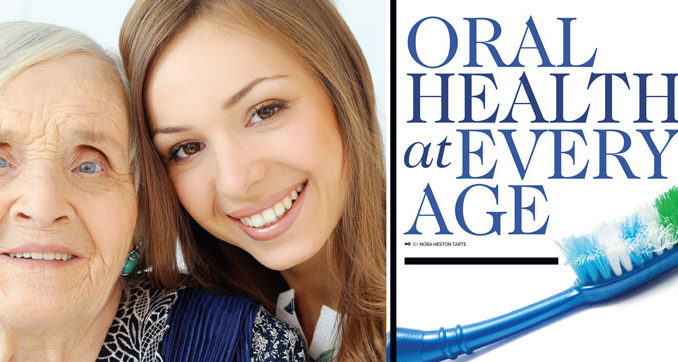

In a world where a lot of emphasis is put on appearance, a bright white smile, filled with straight teeth is an oft-coveted feature. In fact, studies have confirmed that people with straight teeth are viewed as more successful, smarter, and more desirable romantically. They don’t say the most beautiful curve on your body is a smile for no reason.
Combine vanity with the importance of oral health and it’s easy to see why San Joaquinians stress over a good smile. Even if you put appearance aside, most people desire to be healthy and poor oral health has been linked to an increased risk of serious ailments including heart attack, heart disease, stroke, diabetes, and systemic inflammation.
Good oral hygiene requires both home and professional care with the assistance of a dental practice like Queen Creek dental office. Not only is frequent brushing and flossing necessary, so are routine cleanings and x-rays. A good relationship with oral hygiene starts young. It’s never too early for parents to start thinking about their child’s oral health. With good care of your teeth and gums, you shouldn’t have to face many issues, but if you are facing problems with oral hygiene, it’s best to rectify this with help from places like Desert Valley Oral Surgery.
Whatever you do, never stop caring for your teeth. Each age group faces its own issues regarding development, risks, and treatment, but if you stay on top of it, your teeth can last as long as the rest of your body.
Prenatal
Teeth start forming in the womb at about six weeks gestation. This is when the basic substance of the teeth forms, according to Stanford Children’s Health. Around three to four months gestation, fetuses develop hard tissue.
A mother’s diet impacts the health of her child’s teeth. A diet with adequate amounts of calcium, phosphorus, vitamin-C, and vitamin-D help teeth develop correctly. Certain medications should be avoided during pregnancy such as broad-spectrum antibiotics that have been linked to tooth discoloration.
It is also important for women to take care of their own teeth during pregnancy. The rapid change in hormones experienced during pregnancy can cause gingivitis (most often during the second trimester). Symptoms include bleeding gums and gum swelling.
Infancy
We often cite teething as the cause of eating and sleeping problems as well as overall fussiness in infants. Early bloomers may get their first tooth at three months old. Other babies won’t show their first tooth until closer to a year.
Infant “toothbrushes” can be used to gently massage the gums before teeth come in. A wet washcloth over your index finger can achieve the same effect.
As soon as the first tooth erupts, start brushing your baby’s teeth with a toothbrush (toothbrushes are marked with appropriate age ranges so make sure you are buying one that matches your child’s developmental stage). At first, use water. Then, graduate to a rice grain-size amount of non-fluoride toothpaste followed by a pea-sized amount of fluoride toothpaste when your child turns three years old.
 Childhood
Childhood
Tooth decay is the single most common chronic disease of childhood, according to the Centers for Disease Control (CDC). In children ages 12-17, tooth decay is four times more common than asthma (the second must common chronic disease in children).
The American Academy of Pediatric Dentistry recommends that children see the dentist for the first time by their first birthday, or within six months of the first tooth’s appearance above the gum line.
In 2004, a survey found that more than 63 percent of children ages two to four screened in San Joaquin County had never been to a dentist. Only six percent of children younger than two had been.
Help your child brush their teeth for two minutes, twice each day. Always consult your child’s dentist about brushing technique. Individual tooth and gum position can affect which method works best for your child’s mouth. Many a knowledgeable dentist tend to recommend a mixture of circular and back-and-forth motions. Spend extra time brushing your child’s molars where cavities most often occur.
The size of a brush, the safety of the toothpaste, and the age appropriateness of the brush are all important. Children under the age of three (at this age children tend to swallow toothpaste) should not use fluoride toothpaste. Ask your dentist if fluoride-a nutrient that helps fight cavities-supplements are needed.
Fluoride has been linked to the decline of tooth decay and cavities in children and adults. Not only does fluoride reduce the risk of cavities, it can also repair the early stages of tooth decay even before it becomes visible.
Adolescence
During adolescence is when most people get braces. Braces are not necessary for everyone, but they can be used to correct a bad bite or misaligned teeth. Up to 70 percent of U.S. children get braces.
Straightening teeth and correcting bites are not only important to aesthetics (having confidence in your smile can raise self-esteem); they also address other potential oral problems. Straight teeth lead to better overall oral health.
Wisdom teeth are also commonly removed in adolescents (typically age 17-21). About 85 percent of adults have had their wisdom teeth removed. As your last teeth to come in, wisdom teeth tend to not grow in straight, or are in poor position when they come in. This can lead to infections, cysts, pain, and other problems, which is why removal is often recommended.
Smoking, mouth jewelry, drugs, and eating disorders all have a negative impact on oral health. If you suspect any of these issues in your teen, consult a dentist immediately to learn about the effects they can have on oral health.
 Adulthood
Adulthood
See your dentist on schedule, brush and floss every day, use fluoride toothpaste and a soft bristle toothbrush (unless otherwise directed by a professional), and be sure to brush thoroughly down to your gum line. Your dentist may talk to you about braces for adults if they feel like your teeth need help in this stage of your life.
Periodontal disease, caused by bacteria or plaque, is widespread amongst adults, often because it isn’t detected until it becomes painful in its late stages. Early signs include swollen, red, or bleeding gums. See a dentist regularly to catch periodontal disease early.
How often you should get a professional cleaning is a question best left to your dentist. There is not a one size fits all recommendation. Every six months is common advice for how often you should visit the dentist’s, however, some patients may need to see the dentist more often, while others can probably manage on one visit per year.
There are, however, symptoms you should not ignore. If you have pain, bleeding, or sensitivity in your teeth, call your dentist immediately. If you are at-risk for oral issues due to other health conditions, lifestyle choices, or pregnancy, consult a dentist.
Do not put off dental care, especially when a professional has recommended a procedure. Ignoring oral problems could have serious complications or lead to the need for more involved, costly care.
Dental sealants, drinking fluoridated water, using toothpaste that contains fluoride, limiting sugar intake, and having access to dental care are the keys to preventing tooth decay. According to the CDC, approximately 91 percent of U.S. adults had suffered dental caries in permanent teeth (2011-2012).
 Seniors
Seniors
Many seniors experience a second round of cavity prone years, often caused by dry mouth. While dry mouth isn’t a normal side effect of aging, it is a common with many medications used to treat allergies, asthma, high blood pressure, Parkinson’s, Alzheimer’s, and more. Mouthwashes, drinking plenty of water, using a humidifier, and limiting irritants like coffee, alcohol, carbonated soft drinks, and acidic fruit juices can limit the affects.
It’s important to see a dentist often to treat cavities and monitor for signs of tooth decay or gum disease.
Periodontal disease can damage the gums, cause receding gums, and destroy the jawbone, which can in turn cause tooth loss. According to a 2004 survey by the CDC, 20.5 percent of adults over the age of 65 had lost all of their permanent teeth. More had lost some but not all of their teeth.
With proper care and check-ups (including technologies such as x-rays that can detect serious oral problems including osteoporosis, mouth cancer, and infection) dentures may not be necessary.
If an adult does need dentures, proper care of the appliance is important. Dentures should be cleaned after eating, your mouth should be cleaned after wearing dentures, and dentures should be brushed daily and soaked in a dentist-approved solution. Regular dental check-ups are still necessary when an adult has dentures.
Trending Technologies
E-max ceramics Many people who need dental prosthesis are opting to use e-max ceramic crowns instead of the more traditional metal crowns because of their aesthetic appeal and durability. They are often used for teeth that are damaged, stained, or discolored.
3-D imaging Dental x-rays are helpful in determining dental problems such as crooked teeth, wisdom tooth issues, and even osteoporosis, but they don’t always show the whole picture. Dental cone beam computed tomography (CT) allow for better, more thorough images of the teeth, soft tissues, nerve pathways, and bone. They are commonly used when a dentist determines regular dental or facial x-rays are not sufficient.
CAD/CAM Dentistry This is a technology used to improve dental restorations. The computer-aided manufacturing creates more natural looking crowns, veneers, inlays, onlays, bridges, implants, dentures, and orthodontic appliances. The technology allows for dental prosthetics to be created faster with a better overall design that makes insertion more convenient and often cost-effective for patients. In some cases, CAD/CAM technology creates a prosthesis that would be unfeasible otherwise.
For More Information:
Alexander Jhang, DDS
4534 Precissi Ln., #A, Stockton
(209) 957-8940
Rafat S. Razi, DMD MPH
2160 W. Grant Line Rd., #130, Tracy
(209) 834-1307
RaziPediatricDentist.com
Comfort Dental Care
2766 N. Tracy Blvd., Tracy
(209) 836-5393
MyTracyDentist.com
Todd Franklin, DDS
1208 W. Tokay St., Lodi
(209) 334-4370
ToddFranklinDDS.com
Maywell L. Inong, DDS
4568 Feather River Dr., # E, Stockton
(209) 477-9105
InongDental.com
Lester Low, DDS
3133 W March Ln., #1090, Stockton
(209) 474-3333
SmilesDoctor.com
Ronald Noriesta, DDS
4512 Feather River Dr., Stockton
(209) 472-7500
OneAppointment.com
Stockton Dental Care
Caressa W. Louie, DDS
2389 W. March Ln., Ste. 1, Stockton
(209) 952-6721
DrLouieStocktonDentist.com
Suzuki DMD & Associates
801 S. Ham Ln., Lodi
(209) 334-0630
SuzukiDmd.com
Cheema Dental Orthodontics
Multiple San Joaquin locations
(209) 478-6000
CheemaDental.com
Wheeler Orthodontics
4568 Feather River Dr., Ste. D, Stockton
(209) 951-0151
WheelerOrtho.com

